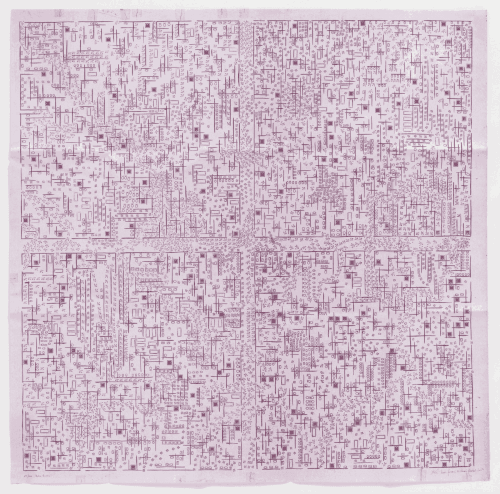LEÓN FERRARI: The Architecture of Madness
February 18 - April 1, 2023
Pan American Art Projects is pleased to announce The Architecture of Madness, a solo exhibition of works by León Ferrari. The Architecture of Madness will be on view from February 18 of 2023, with an opening reception on Saturday February 18, from 6 to 9 pm.
Having left Buenos Aires for political exile in the great metropolis of Sao Paulo, Leon Ferrari was struck by the multitude of people, and their very similar lifestyles: he expressed this repetitiveness in a series of heliographs. Twenty seven designs, made between 1980 and 1986, were printed with the Letraset technique used by architects. He saw the heliographs as representing “the absurdity of contemporary society, that sort of madness necessary for everything to look normal”[L.F.]
There was one additional reference in the rigidity of repetitiveness: an association with the horror of regimentation imposed by the military dictatorship in Argentina, which had murdered his son in the family home and forced him to take the rest of the family to safety abroad. This association may explain why Ferrari conveyed with a sense of horror the way of life in super-urban civilizations.
From the viewer’s point of view, unaware of the artist’s intent and background, chaos and confusion seem to reign; but from the point of view of the inhabitants of these almost identical spaces, they seem to live a normal life in their urban labyrinthine nightmare.
Perhaps in search of a respite from that ‘madness’, Ferrari turned to sound; he became interested in producing music, which he achieved with his tubular sculptures. Sensitive to wind, touch, and movement, these created chaotic compositions, out of rhythm, reminiscent of his drawings on paper from the 60’s, in which the hand might suddenly jettison downward two lines or more, in total break with conventional order. Ferrari’s written drawings from the 70s were organized more traditionally, along parallel horizontal lines quite reminiscent of a sheet of music. Gone are the exuberant transgressions of the Sixties, which must have appeared chaotic to his audience, much as the heliographs did twenty years later in a return to chaos.
We find again a visual as well as philosophical correlation between Ferrari’s small figures of the heliographs and musical notes. Indeed, his first institutional exhibit in Sao Paulo included, along with drawings, both heliographs and musical sculptures. [It should be noted that Ferrari discontinued his experiments in the creation of sound when he learned that Harry Bertoia was working along similar lines].
Most of the heliographs are nothing more than the repetition of the same image, whether a human figure, or a door, or a bidet: a reiteration necessary to describe ‘normal’ human conditions. These could be seen as the equivalent, in music, of simple refrains, repeated over and over until the audience joins in, and forgets to escape. In other heliographs, there is total chaos, as where masses of people march in opposite or perpendicular directions, destined to crash, and they do. In still others, nonsensical doors open in succession into other spaces without a final exit, in an impossible architectural design; or highways go around in circles, again without exit. The two types of heliographs represent extremes of life, both being surrealistic and incomprehensible.
Toward the end of his life we produced for Ferrari a photogravure which represented a final synthesis of his work: lines instead of words, as everything has been said; a musical sheet without notes, just their memory. And yet, upon close inspection, we see that the lines have subtle movements, they are still alive: they carry the ghosts of thousands of interpretations, of arrangements, of compositions.
With the help of the Ferrari Foundation, which provided the one we were missing, we are able to present them all twenty six in this exhibition.
Robert Borlenghi
[In affectionate observance of ten years since Leon’s passing, in 2013]


